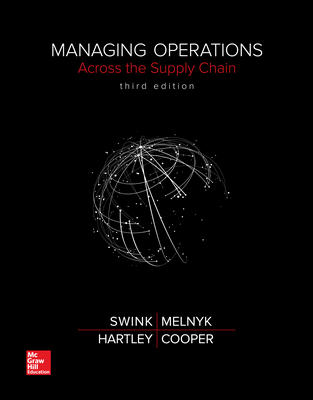Description
Managing Operations Across the Supply Chain 3rd Edition By Morgan Swink – Test Bank
Chapter 5
1. Which of the following process structures can produce the widest variety of products?
A. Job shop
B. Repetitive process
C. Continuous flow
D. Batch operation
Job shop processes produce the widest variety of the listed process types.
AACSB: Reflective Thinking Blooms: Remember Difficulty: 1 Easy
Learning Objective: 05-01 Compare and contrast the seven process structures: project; job shop; batch; repetitive process; continuous process; mass customization; and cellular manufacturing.
Topic: Process Structures
2. Which process type is not correctly matched with its descriptive characteristic?
A. Project-high complexity
B. Repetitive process-customized products
C. Job shop-high flexibility
D. Continuous flow-low-skilled workers
Repetitive processes typically produce standardized products. The other choices are correct (see Table 5-1).
AACSB: Reflective Thinking Blooms: Remember Difficulty: 1 Easy
Learning Objective: 05-01 Compare and contrast the seven process structures: project; job shop; batch; repetitive process; continuous process; mass customization; and cellular manufacturing.
Topic: Process Structures
3. Which of the following types of businesses would most likely use a batch process structure?
A. Company that builds cruise ships.
B. An automotive assembler such as Ford Motor Co.
C. A glass beverage bottle manufacturer.
D. A company that produces automobile seats.
Automobile seats have moderate volumes and varieties considering such factors as differences in upholstery and thus would use a batch process (see Table 5-1).
AACSB: Reflective Thinking
Blooms: Apply
Difficulty: 2 Medium
Learning Objective: 05-01 Compare and contrast the seven process structures: project; job shop; batch; repetitive process; continuous process; mass customization; and cellular manufacturing.
Topic: Process Structures
4. Wanda Corp. currently uses a job shop process. It wants to maintain the advantages of this but increase efficiency. Wanda should investigate:
A. Cellular manufacturing.
B. Job shop processes.
C. Mass customization.
D. Project process.
Cellular manufacturing attempts to maintain flexibility of job shops but at lower costs.
AACSB: Reflective Thinking Blooms: Apply Difficulty: 1 Easy
Learning Objective: 05-01 Compare and contrast the seven process structures: project; job shop; batch; repetitive process; continuous process; mass customization; and cellular manufacturing. Topic: Process Structures
5. Zanda Corp. wants to have a process structure that has cost advantages similar to continuous or repetitive processes, but wants to produce greater variety than those processes normally allow. Zanda should consider:
A. Cellular manufacturing.
B. Job shop processes.
C. Mass customization.
D. Project process.
Mass customization attempts to maintain cost advantages similar to continuous or repetitive processes, but allows a firm to produce greater variety than those processes normally allow.
AACSB: Reflective Thinking
Blooms: Apply
Difficulty: 2 Medium
Learning Objective: 05-01 Compare and contrast the seven process structures: project; job shop; batch; repetitive process; continuous process; mass customization; and cellular manufacturing.
Topic: Process Structures
6. Jones Company has a make-to-order orientation. It most likely does NOT use:
A. Continuous process structure.
B. Cellular manufacturing process structure.
C. Job shop process structure.
D. Batch process structure.
AACSB: Reflective Thinking Blooms: Understand Difficulty: 1 Easy
Learning Objective: 05-01 Compare and contrast the seven process structures: project; job shop; batch; repetitive process; continuous process; mass customization; and cellular manufacturing.
Topic: Process Structures
7. Companies with a make-to-stock orientation are most likely to use which of the following process structures?
A. Mass customization
B. Job shop
C. Repetitive process
D. They are likely to use any one of these process structures.
Of the alternatives, only repetitive process applies to make-to-stock. The others are make or assemble to order.
AACSB: Reflective Thinking Blooms: Remember Difficulty: 1 Easy
Learning Objective: 05-01 Compare and contrast the seven process structures: project; job shop; batch; repetitive process; continuous process; mass customization; and cellular manufacturing.
Topic: Process Structures
8. For which market orientation is accurately forecasting the amount of finished goods needed likely to be the most important for a firm’s financial performance?
A. Engineer to order
B. Make to order
C. Assemble to order
D. Make to stock
In a make -to-stock orientation, products are made in advance of actual customer orders and held in inventory. Thus, forecasting is critical to both costs and sales. Firms using the other orientations do not produce finished goods until after a customer order is received.
AACSB: Reflective Thinking Blooms: Understand Difficulty: 3 Hard
Learning Objective: 05-01 Compare and contrast the seven process structures: project; job shop; batch; repetitive process; continuous process; mass customization; and cellular manufacturing.
Topic: Process Structures
9. Which of the following products is most likely to use an assemble-to-order market orientation?
A. An upholstered sofa
B. A mobile phone
C. Shampoo
D. A race car
For an upholstered sofa using an assemble-to-order orientation, the premade frames are held in inventory but the fabric is not added until a customer order is placed. Sofas can also be make to stock.
AACSB: Reflective Thinking
Blooms: Apply
Difficulty: 2 Medium
Learning Objective: 05-01 Compare and contrast the seven process structures: project; job shop; batch; repetitive process; continuous process; mass customization; and cellular manufacturing.
Topic: Process Structures
10. Choose the service type that is correctly matched with one of its key characteristics.
A. Service factory facilities and equipment represent a large proportion of total costs.
B. Service There is a low degree of customer interaction.
C. Mass service transactions are very varied from customer to customer.
D. Professional service transactions tend to be fairly standardized.
A service factory requires high capital investment. The other descriptions are opposite of the reality. See Figure 5-2.

Reviews
There are no reviews yet.